You need good SEO to drive significant organic traffic and conversions. And that’s why you definitely can’t do without SaaS keywords.
The only problem is – getting the right keywords to rank for can be a big deal.
According to our Co-founder, Vibhu Dhariwal, most new startups or underperforming SaaS brands target:
- highly competitive keywords that are too difficult to rank for
- high-volume keywords with little or no conversions
- low-volume keywords that barely record any traffic or conversion
To solve these problems, I’ve compiled a comprehensive guide below, including some of the best practices we follow in Digital Gratified to help you build a SaaS keyword research strategy that works.
What Is SaaS Keyword Research?
SaaS keyword research is a stepwise approach to digging out keywords, terms, or queries that are relevant to your product or services.
Basically, you want to know what people type into engines like Google, Bing, and even social media platforms when looking for your brand.

The reasons for conducting SaaS keyword research are to increase your brand awareness, boost website visibility, and most importantly – improve lead generation.
What Are SaaS Keywords?
SaaS keywords are significant terms or relevant queries that your customers search for on the internet when they need help with something, want to learn more about a topic, or need useful resources.
And it can be a short-tail keyword such as:
- Customer Relationship Management
- CRM software
- Accounting software
Or long-tail keywords like:
- Best customer relationship management software for small businesses
- Top-rated customer relationship management tools for e-commerce startups
- Cheapest CRM software in 2024
The thing is, there are possibly thousands and tens of thousands of keywords related to your brand.
But by conducting a keyword research, you can easily sort out these pool of keywords and simply use the relevant ones to optimize your website for better Search Engine Ranking Position (SERP).
3 Factors To Consider Before Doing A SaaS Keyword Research
Before conducting keyword analysis for SaaS brands, you must consider customer intent, sales funnel, and keyword difficulty.
These factors will help you focus on keywords that truly move the needle and drive in leads that convert.
#1 Sales Funnel: How To Do Keyword Research For All Stages
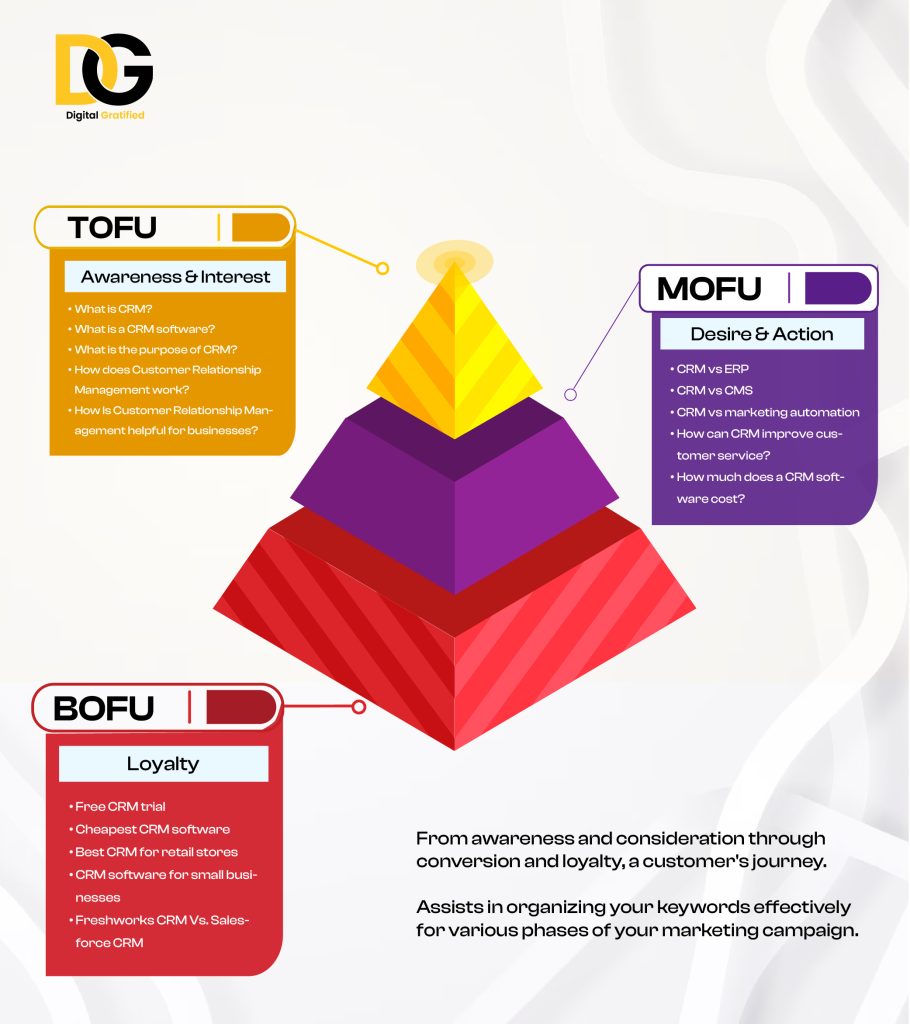
The sales funnel is an imaginative pathway that highlights a customer’s journey from awareness and consideration to conversion and loyalty. It is mainly divided into TOFU, MOFU, and BOFU.
Purpose: Helps you categorize your keywords for good use at different stages of your marketing campaign.
SaaS Top Of The Funnel (TOFU) Keywords: Awareness
SaaS Top Of The Funnel Keywords are those search terms people use to find answers or explore resources online. At this stage, they have no clear idea of your product, but they have a problem – and a question on how it can be solved.
Some of the SaaS TOFU keywords include:
- What is CRM?
- What is a CRM software?
- What is the purpose of CRM?
- How does Customer Relationship Management work?
- How Is Customer Relationship Management helpful for businesses?
Everything at this stage is for awareness and traffic generation, not sales or conversions.
SaaS Middle Of The Funnel (MOFU) Keywords: Consideration
SaaS Middle Of The Funnel Keywords are terms prospects search for when they are in the consideration stage. They already have an inkling of the service you provide, but they need to know why you should be their “problem solver”.
At the MOFU stage, SaaS keywords usually revolve around:
- CRM vs ERP
- CRM vs CMS
- CRM vs marketing automation
- How can CRM improve customer service?
- How much does a CRM software cost?

You can see how these keywords are more specific and targeted towards the problem-solver compared to TOFU.
SaaS Bottom Of The Funnel (BOFU) Keywords: Decision
Unlike in MOFU, prospects at the BOFU stage are either already interested in buying your product or are previous customers.
And they only need a slight push to make a decision. Of course, this stage also records most dumps – cart dump, halfway purchase, and switching over to competitors.
Some of the popular SaaS Bottom Of The Funnel Keywords include:
- How much does a CRM software cost?
- Free CRM trial
- Cheapest CRM software
- Best CRM for retail stores
- CRM software for small businesses
- Freshworks CRM Vs. Salesforce CRM
#2 Mapping Customer Intent With Keywords
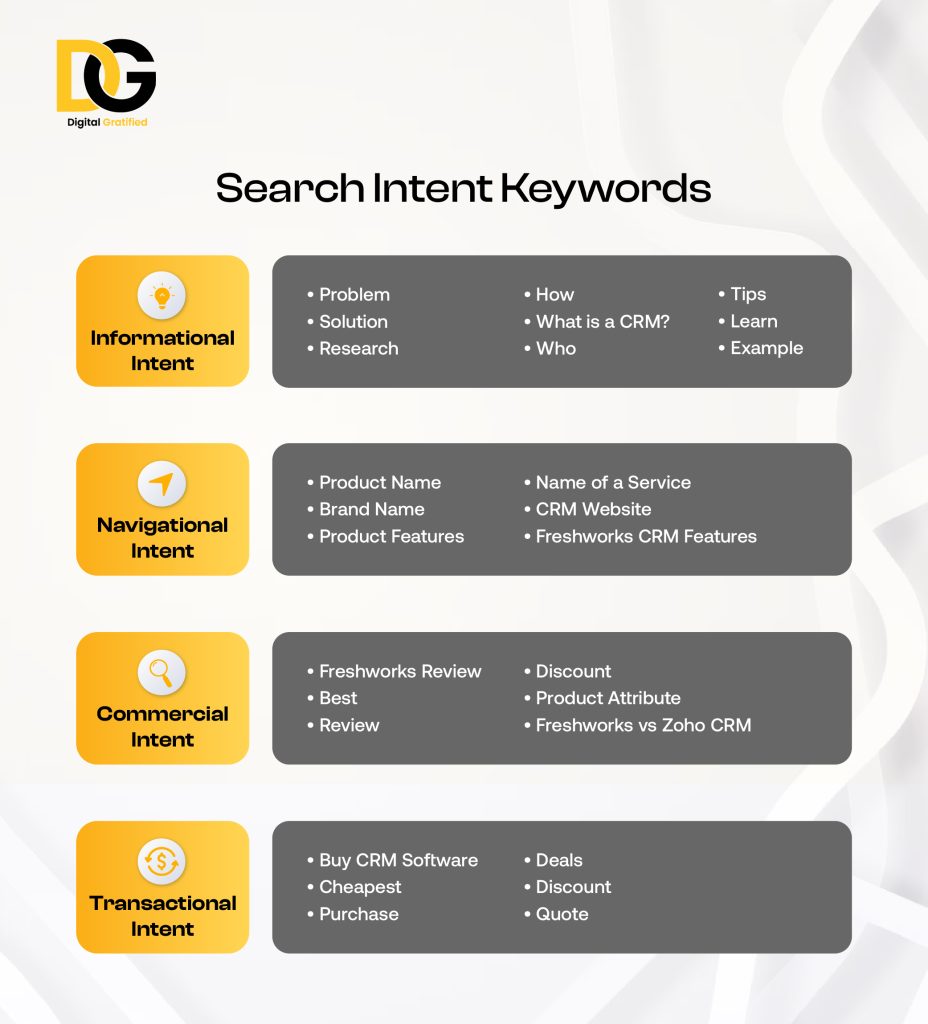
Another simple way to group your keywords besides using a marketing funnel is through intent mapping. Intent is the main thought or reason behind a customer’s action during any touch point of their purchase journey.
Purpose: Helps you understand which keywords are more conversion-specific. Secondly, intent mapping lets you know how to incorporate certain keywords in your content for SaaS lead generation.
Informational Intent
Informational intent is more or less similar to the TOFU stage of marketing funnel. Customers at this stage simply want to learn more about something – their problem, a solution, just random discovery for fun, research.
Since they are purely informational, then these keywords must carry some questioning intent such as “How does CRM help businesses”, “What is a CRM?”, “CRM for businesses”.
Everything from How, Why, and When goes.
Navigational/Local Intent
Unlike informational intent, customers are more specific with their search terms. They’re either looking for a product name, brand review, a particular product’s features, name of a service, or finding a website’s login.
Relevant navigational keywords include “CRM website” and “freshwork CRM features and pricing”.
Commercial Intent
Keywords with commercial intent are only used when prospects already know your brand but want to review, compare, and investigate if you have other better-performing alternatives.
These are usually a clear mix of BOFU and MOFU keywords. So you should have something like “Freshworks review”, “Freshworks vs Zoho CRM”, “Freshworks alternatives”, and “CRM software package discount”.
Transactional Intent
Then we have the transactional intent keywords which are primarily BOFU. People who use these search terms are clearly ready to make a purchase – they just need a final navigation to the right provider and the much anticipated sale.
Without mentioning, I bet you’re already making a mind note of keywords like “buy CRM software”, “cheapest CRM subscription package online”, and “Purchase hubspot CRM tool”.
#3 Keyword Difficulty And How It Impacts Your SaaS SEO
Keyword difficulty is a metric that measures how difficult it will be to rank for a certain keyword. As powerful as this metric is, most brands tend to ignore it in their SEO calculations. This is a fatal mistake because you could be picking keywords that are too difficult to rank for.
So now, the next question should be – what factors make a keyword difficult to rank for?
Most SEOs often whip up many points to answer this, but let’s just focus on three:
- Industry: Most industries like SaaS are innately competitive. The big moguls spend hundreds of thousands to stay in their top sphere for several keywords through expensive link building approaches, rigorous SaaS content marketing practices, stringent editorial rules, and good website SEO.
That makes it very difficult for new startups to gain traction with the same keywords. - Backlinks profile: All keywords are innately easy to rank for until a reputable domain with hundreds of thousands of backlinks makes it difficult. I mean that anytime a big domain ranks for a particular keyword, that keyword automatically gains some ranking difficulty.
It’s like how Bill Gates or Elon Musk can increase the cost of a $10 bathing soap by just using it once.
The big headache is that you need to either match up that same number of backlinks or maybe near in order to pull up some ranks. Of course, other SEO practices, like quality content, might help. But they’re not as effective as having a sturdy backlink profile. - Search Volume: Search volume refers to the number of times a keyword gets looked up. Most keywords can have as little as zero and as high as tens of millions monthly. As for the latter, the difficulty is usually very high.
This is also why most SEOs recommend low-traffic keywords for new SaaS startups until they have gained enough backlink power and domain authority to pursue the high-traffic ones.
Keyword difficulty is measured on a scale of 100 if you use tools like SE Ranking, SEMrush, and Ahrefs. And the higher the scale, the more difficult it is to rank for that keyword.
Likewise, keywords with lower difficulty are more rankable. Those with zero difficulty are the easiest to rank for but that comes at the cost of little or no traffic.
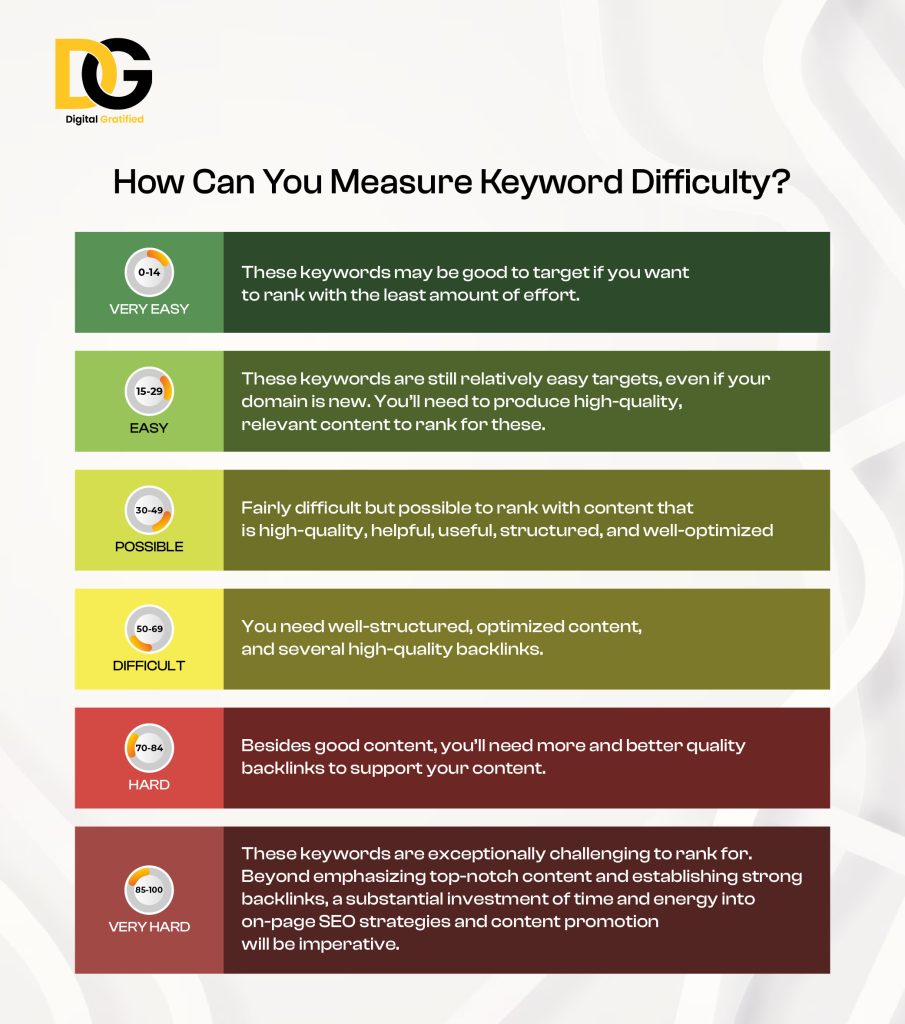
10 Brutally Effective SaaS Keyword Research Process
Keyword research for SaaS is a lot of work. And that’s why most brands prefer outsourcing it to a professional digital marketing agency.
But that’s not an issue, as I’ll break the whole process down below with screenshots wherever possible.
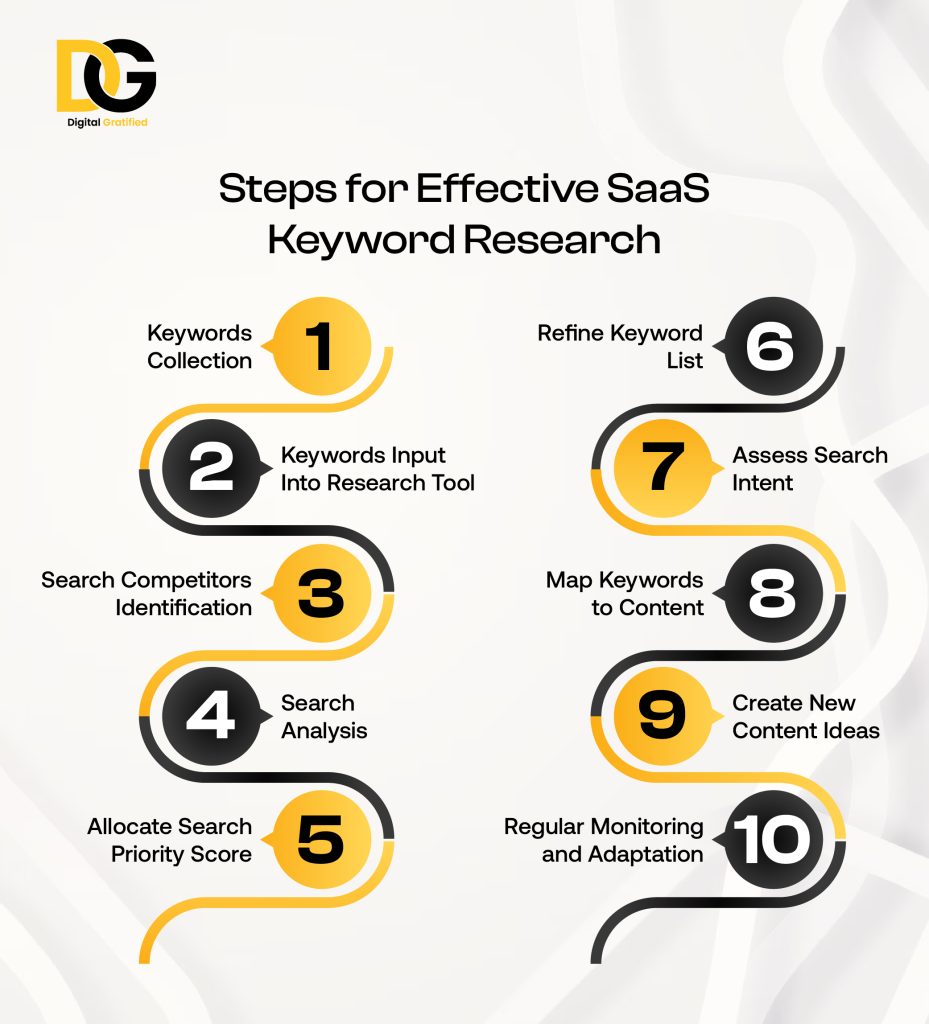
1. Collect A Pool Of Potential Topics And Seed Keywords
Let’s start with the basics.
Seed keywords are those primary terms that represent your product and services. For instance, if your SaaS brand provides CRM software like HubSpot, then your seed keyword is “CRM software”.
However, stopping there gives us no tangible result. These types of short-tail keywords are often too difficult to rank for since several millions of websites already use them, and they have several tens of thousands of monthly search volume.
As you can see in the image above, the “CRM software” keyword has a difficulty score of 70.
The main reason we need these short-tail keywords is so that we can pull up more long-tailed, relevant keywords that are actually usable. More on this soon.
Go ahead and make a list of your seed keywords – the more, the better. Then create potential topics that you think will be a good fit for your brand. These topics are as useful as our seed keywords and can be used to generate more comprehensive topic ideas.
You can also extract their topic if you already have some published content. Once you have all these seed terms and topics, export them into a spreadsheet and categorize them for easy sorting.
2. Input The Initial List Into Your Preferred Keyword Research Tool
Here comes the real job.
We need to input each of the seed keywords we’ve collated one by one into a keyword research tool. For this, I’ll use SE Ranking. After inserting my primary keyword “CRM software” into the keyword analytics tool, scrolling down, this is what I got below.
So, for the seed keyword – I have approximately 2200 similar keywords, close to 10,000 related keywords, and several long-tailed question-like keywords.
Go ahead and do the same thing for your remaining seed keywords. Don’t forget the topics you’ve gathered, too. Dig in to get some useful keyword ideas you get.
Afterward, export everything back into your spreadsheet. Use a separate sheet for each seed keyword to avoid mix-ups.
3. Utilize Your Seed Concept Categories To Identify Search Competitors
I always tell new SEOs to always do competitor analysis when looking for rankable keywords. The same thing applies to backlinks – you can only see what relevant links to fill in for when you do competitor backlinks analysis.
So how can you do that?
Depending on the SEO tool you are using, most common ones like Ahrefs, SEMrush, and SE Ranking, add an additional section after the initial analysis in step 2 to display which websites are ranking for your seed keywords. Check the image below.
The list goes on and on, but let’s focus on the top SERP results only. These domains are your direct and indirect competitors. Direct competitors are those offering the same CRM software as you, such as Zoho, Zendesk, and Salesforce.
On the other hand, indirect competitors such as G2 and PC Mag do not offer a CRM product, but they still rank for it through review content.
Once you have a significant list of your direct and indirect competitors, export them into a spreadsheet and name them separately for better digging.
Starting with our first direct competitor here – Zoho, click the bar, and you will be taken to a new page solely for Zoho analysis. You can also copy the link, go to the Competitive Research bar, paste, and search. Here’s what mine looks like:
But I’m not currently interested in Zoho’s site details. Here I need the keywords they target to rank on top of Google’s SERP. To get that, just scroll down, and you will see something like this:
You can see all the keywords that Zoho ranks for including their position on Search Engine Result Pages (SERPs).
Export all of them. Those are our juice keywords. Repeat the same procedure for other competitors on the SERP.
4. Analyze Search Volumes And Extract The Relevant Ones
We probably have tens of thousands of keywords already. I guess you now know why SaaS keyword research is a lot of work. But it’s worth it when you begin to rank high on search engines.
Our next step is to analyze the search volume for each term. However, you don’t need to do this manually. During step two and three, the keywords we extracted already come with a keyword difficulty (KD) value, search volume, CPC, and even competitive ratio.
You can also use the bulk analysis tool to extract the search volume of all your keywords if necessary.
Based on search volume and KD, categorize your keywords into four:

- Low KD but high traffic and value
- High KD with high traffic and value
- Low KD with little or no traffic and value
- High KD with little or no traffic (This is almost impossible)
The first two are our main focus. You can keep the rest in the trash bin and go to step.
5. Allocate A Search Priority Score To Each
After the initial sorting in step 4, you should now have fewer keywords than before. Next thing is to assign a search priority score on a scale of 0 to 1. 0 is the lowest, 0.5 is medium, and 1 is high priority (my preferred scale).
While search priority is almost similar to search volume, they are actually very different. Search volume only focuses on the number of searches for a particular keyword, but search priority altogether includes volume, competitive ratio, and intent.
A keyword can have a very high search volume but be irrelevant to your marketing goals. This is also why most brands have a good flow of traffic but fewer conversions.
6. Edit Your Keyword List For Fluffs
The next step is to review and take out search terms that do not fit in well. There will definitely be some repetitive keywords in your list. And some search terms might also come as broken phrases or incorrect sentences.
Note: You have to avoid replacing juicy links that are grammatically incorrect, unless absolutely necessary.
You can also bring in your content team at this stage to see which keywords make it into the final list.
7. Consider And Attribute User’s Search Intent
We’ve discussed intent mapping before – Informational, navigational, commercial, and transactional. In your spreadsheet, create an additional column to include intent for each keyword.
Personally, I prefer putting the keywords under each intent in a separate spreadsheet. This gives me a holistic view and helps me focus on a particular set of search terms compared to when everything is juggled together in a single spreadsheet, as shown above.
You should now have a ready-to-use keyword list.
8. Map Target Keywords To Existing Content Assets
The next step is to incorporate them into your existing content. This is going to take a whole lot of editing if you have hundreds of published blog posts. But if you have a content team, it shouldn’t be a problem.
Here’s how to do keyword incorporation properly:
- Outline the topics of your previously published pieces.
- Assign your primary or seed keywords in addition to other relevant keywords to each topic.
- Since these blog posts were not written with your new keywords in mind, you might need to do some restructuring, add new subheadings, remove a few sections, or even revamp the whole piece.
- Your keywords should flow with their surrounding content. Try not to sound sale-sy if you’re using a seed search term.
- Avoid keyword stuffing. Google frowns at this practice and considers it a negative ranking signal.
- Maintain keyword consistency especially if you use the topic cluster strategy.
9. Brainstorm New Content Ideas To Fill Gaps
By the time you’re done incorporating your keywords into existing content, you will still be left with tons of secondary keywords or underused seed search terms. The best way to go is by creating new content ideas.
Mind you, you can expand your keywords to brainstorm new topic ideas. That’s a dealbreaker for your competitors and a faster way to create an inexhaustible list of topics.
You can also collaborate with every other department in your company, especially the customer support team. Customer support departments are the frontline of your SaaS business and they have a record of common customer queries (which are most likely part of your extracted keywords already).
Collate these ideas and let your content engines move their wheels.
10. Monitor, Review, And Adapt Regularly
Keyword research is a dynamic and an unending process for as long as Google and other search engines keep updating their algorithm. You should always monitor the trends, see the new search terms bringing in traffic, evaluate their relevance, and fix them in your list.
Also, you need to constantly review your existing keywords. A few of them can lose their relevance. If this happens seasonally, that’s not a problem. For instance, keywords like “black friday software sale” are seasonal and generate more traffic and conversions towards the year’s ending.
7 Ways To Generate More SaaS Keywords That Drive Conversions (By SEO Managers)
Here are more ways to generate traffic and conversion-oriented keywords.
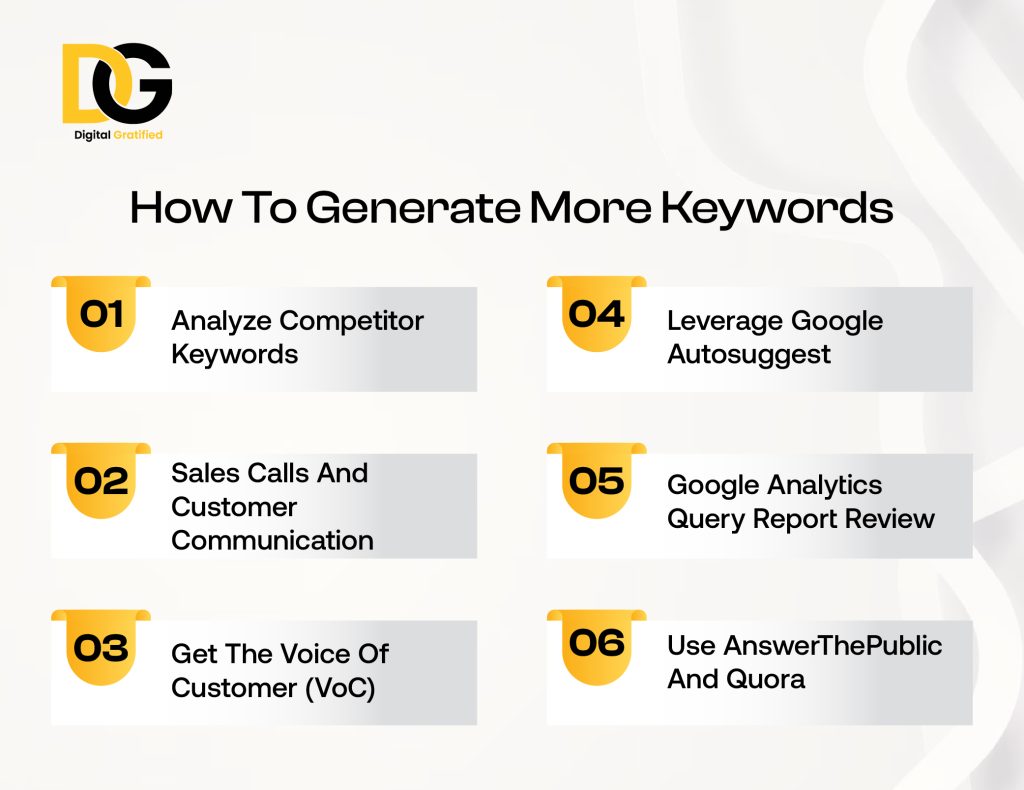
Analyze Competitor Keywords
If you’re looking for the best place to get keywords that truly move the market, then it will be your competitors. These brands have already tried out several keyword research strategies and gotten one that works well for them.
Moreover, for them to top the SERPs, it means they have a tangible database of keywords. So instead of reinventing the wheel, why not just live off their efforts?
To do that, first type in your product’s seed keyword into Google’s search bar. Then note the first 10 direct competitors that pop up. Conduct a competitive research analysis on each competitor with your SEO tool and see the thousands of keywords they rank for.
Export these keywords into a spreadsheet and follow the keyword research process that I shared above.
Check Out Customer Communication Database
Your sales and customer support department are always at the forefront of your business – I mentioned this before. This means they have thousands of recorded calls and chats in their database. Extract these data and analyze them for common queries.
These queries are your cue and the best way to reach inside your customer’s head. Put them in your keyword research tool and conduct a more comprehensive analysis.
Use Review Forums Like Capterra To Get The Voice Of Customer (VoC)
Voice of Customer (VoC) is similar to Sales call analysis since both approaches help you know what prospects and customers think. But VoC has nothing to do with your communication department and instead focuses on external, unbiased review forums like Capterra and G2.
Your goal is to visit these review forums and see what customers are saying or complaining about. For instance, Capterra reviewed HubSpot CRM and published some of its pros and cons according to previous and existing users.
Source: Capterra
By leveraging these cons, you can create a comparison article where you show how your CRM product does well in those areas where HubSpot lags. Of course, you need to first analyze the comparison topic with your preferred SEO tool so that you can extract a list of related or commercial keywords to use.
Leverage Google Autosuggest
Google’s auto-suggest is an integrated algorithm that brings out a list of related queries when you type something in the search bar.
While this list is not comprehensive enough, you can still use it as a secondary source to generate keywords that your SEO tool otherwise skipped. And of course, you don’t need everything. Just pick one or two relevant ones and analyze them.
Go On Sales Call
Although most brands prefer using textual means to engage clients, going on a call once in a while shouldn’t hurt. Importantly, you can use that opportunity to hear how your brand users feel or what they would have wanted you to do.
We are also in an era where sales calls can be auto-recorded and transcribed for future review. Some AI tools like Salescloser.ai even go as far as analyzing each call and giving you sales-closing insights which you can use in your marketing strategy. However, what we are concerned about is the trove of queries analyzed from these calls since they form the basics of your keyword research and on-page SEO.
Review Google Analytics Query Report
This is my favorite go-to on a daily basis. The Google analytics query report shows some of the search terms that make your website pop up on SERPs.
This report doesn’t mean you’re ranking on SERP yet or have a click for the query; but it helps you know what search terms you should focus on
Go ahead and extract everything for keyword analysis.
Use AnswerThePublic And Quora
AnswerThePublic is a social listening tool that helps you extract the keyword and phrases people use online and on social media. Moreover, it adds related information, search volume, questions, comparison, and cost per click for each keyword.
Another valuable keyword source is Quora. Tens of thousands of people ask extremely personal and relevant questions on this social media platform. And most SEOs have taken it as a way to build authority and backlinks by providing answers.
But beyond that, you can extract the queries there and explore them using your keyword research tool.
The Big Question: After Keyword Research, What’s Next?
The main purpose of SaaS keyword research is to boost your SEO. Once you have your keywords, then you can:
Write Brilliant Content And Optimize Existing Ones For SEO
Create yay-worthy content that’s highly relevant and customer-centric. Incorporate your keywords seamlessly in them. Don’t also forget to optimize your existing content with the keywords. This will boost their position on SERPs and help you generate more valuable traffic.
Get Quality Backlinks & Increase Domain Authority
Google takes quality backlinks as one of its major ranking signals. So after keyword incorporation, the next thing is SaaS link building. The higher the KD of your keywords, the more quality backlinks you will need to rank for them on SERPs. Check out our piece on link building pricing.
Promote Across Relevant Channels
Although SEO is very powerful, it can’t do all the pushing. You need to manually promote your blog posts and web content using different channels including social media. You can also run paid ads for pillar pages containing your seed keywords until your SEO efforts fully kick in.
Measure And Iterate For Improvement
After implementing this new SaaS keyword strategy, compare and contrast your traffic outcome over the course of six months. Then figure out what’s working and what’s not for immediate review. Depending on the analysis, you can figure out how you should move forward.
In A NutShell
Keyword research makes up a crucial part of your SEO strategy, but it gets so overwhelming sometimes. And that’s why we are here. At Digital Gratified, we create personalized keyword strategies backed with quality link building campaigns for SaaS brands who want more sales.
See what our Co-founder has to say,
Over the last three years, we have built thousands of backlinks for SaaS businesses. Our link building services helped new SaaS products get traffic of thousands from zero, and well-established SaaS brands doubled and even tripled their traffic in just a few months. All that was done at a lesser cost than the average cost for building or expanding in-house teams for link building.


